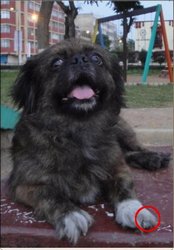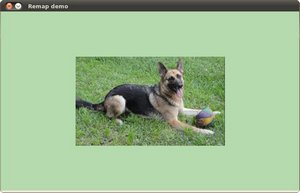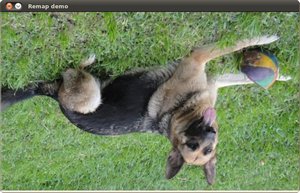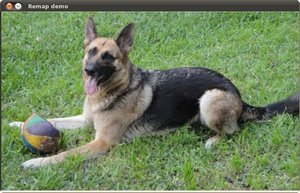https://docs.opencv.org/2.4/doc/tutorials/imgproc/imgtrans/remap/remap.html
Goal
In this tutorial you will learn how to:
- Use the OpenCV function remap to implement simple remapping routines.
Theory
What is remapping?
It is the process of taking pixels from one place in the image and locating them in another position in a new image.
To accomplish the mapping process, it might be necessary to do some interpolation for non-integer pixel locations, since there will not always be a one-to-one-pixel correspondence between source and destination images.
We can express the remap for every pixel location
![(x,y)]() as:
as:![g(x,y) = f ( h(x,y) )]()
where
![g()]() is the remapped image,
is the remapped image, ![f()]() the source image and
the source image and ![h(x,y)]() is the mapping function that operates on
is the mapping function that operates on ![(x,y)]() .
.Let’s think in a quick example. Imagine that we have an image
![I]() and, say, we want to do a remap such that:
and, say, we want to do a remap such that:![h(x,y) = (I.cols - x, y )]()
What would happen? It is easily seen that the image would flip in the
![x]() direction. For instance, consider the input image:
direction. For instance, consider the input image:![Original test image]()
observe how the red circle changes positions with respect to x (considering
![x]() the horizontal direction):
the horizontal direction):![Original test image]()
In OpenCV, the function remap offers a simple remapping implementation.
Code
- What does this program do?
- Loads an image
- Each second, apply 1 of 4 different remapping processes to the image and display them indefinitely in a window.
- Wait for the user to exit the program
- The tutorial code’s is shown lines below. You can also download it from here
Explanation
Create some variables we will use:
Load an image:
Create the destination image and the two mapping matrices (for x and y )
Create a window to display results
Establish a loop. Each 1000 ms we update our mapping matrices (mat_x and mat_y) and apply them to our source image:
The function that applies the remapping is remap. We give the following arguments:
- src: Source image
- dst: Destination image of same size as src
- map_x: The mapping function in the x direction. It is equivalent to the first component of
![h(i,j)]()
- map_y: Same as above, but in y direction. Note that map_y and map_x are both of the same size as src
- CV_INTER_LINEAR: The type of interpolation to use for non-integer pixels. This is by default.
- BORDER_CONSTANT: Default
How do we update our mapping matrices mat_x and mat_y? Go on reading:
Updating the mapping matrices: We are going to perform 4 different mappings:
Reduce the picture to half its size and will display it in the middle:
![h(i,j) = ( 2*i - src.cols/2 + 0.5, 2*j - src.rows/2 + 0.5)]()
for all pairs
![(i,j)]() such that:
such that: ![\dfrac{src.cols}{4}<i<\dfrac{3 \cdot src.cols}{4}]() and
and ![\dfrac{src.rows}{4}<j<\dfrac{3 \cdot src.rows}{4}]()
Turn the image upside down:
![h( i, j ) = (i, src.rows - j)]()
Reflect the image from left to right:
![h(i,j) = ( src.cols - i, j )]()
Combination of b and c:
![h(i,j) = ( src.cols - i, src.rows - j )]()
This is expressed in the following snippet. Here, map_x represents the first coordinate of h(i,j) and map_y the second coordinate.
 as:
as:
 is the remapped image,
is the remapped image,  the source image and
the source image and  is the mapping function that operates on
is the mapping function that operates on  and, say, we want to do a remap such that:
and, say, we want to do a remap such that:
 direction. For instance, consider the input image:
direction. For instance, consider the input image:



 such that:
such that:  and
and 







